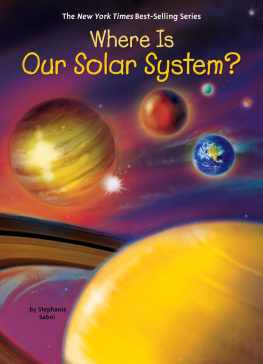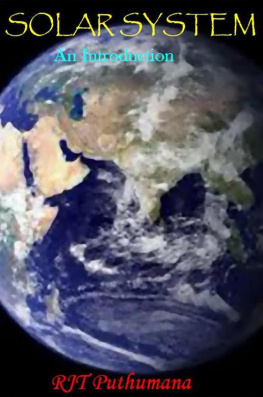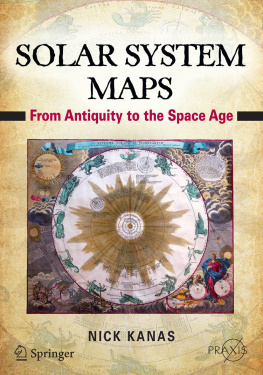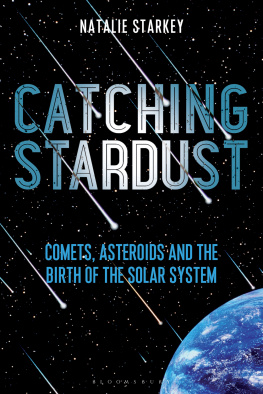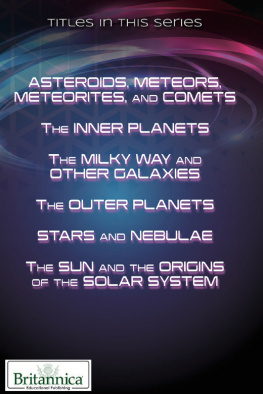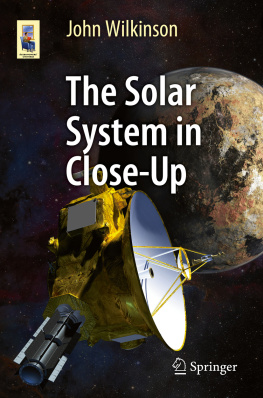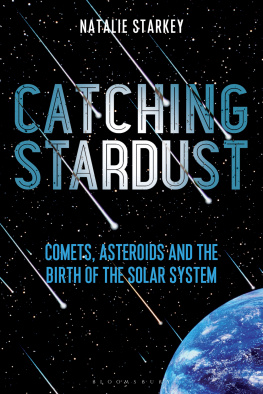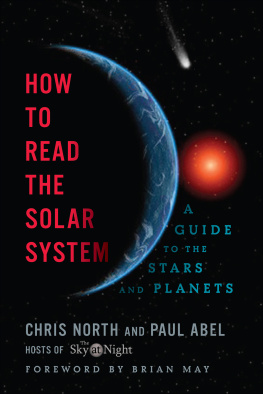Contents
Pagebreaks of the print version
Small Bodies
of the
Solar System
A Guided Tour for Non-Scientists
Small Bodies
of the
Solar System
A Guided Tour for Non-Scientists
Hans Rickman
PAS Space Research Center, Poland
Uppsala University, Sweden

Published by
World Scientific Publishing Europe Ltd.
57 Shelton Street, Covent Garden, London WC2H 9HE
Head office: 5 Toh Tuck Link, Singapore 596224
USA office: 27 Warren Street, Suite 401-402, Hackensack, NJ 07601
Library of Congress Cataloging-in-Publication Data
Names: Rickman, H. (Hans), author.
Title: Small bodies of the solar system : a guided tour for non-scientists /
Hans Rickman, PAS Space Research Centre, Poland, Uppsala University, Sweden.
Description: New Jersey : World Scientific, [2022] | Includes bibliographical references and index.
Identifiers: LCCN 2021016036 (print) | LCCN 2021016037 (ebook) |
ISBN 9781800610514 (hardcover) | ISBN 9781800610606 (paperback) |
ISBN 9781800610521 (ebook for institutions) | ISBN 9781800610538 (ebook for individuals)
Subjects: LCSH: Solar system--Popular works.
Classification: LCC QB501.2 .R53 2022 (print) | LCC QB501.2 (ebook) | DDC 523.2--dc23
LC record available at https://lccn.loc.gov/2021016036
LC ebook record available at https://lccn.loc.gov/2021016037
British Library Cataloguing-in-Publication Data
A catalogue record for this book is available from the British Library.
Copyright 2022 by World Scientific Publishing Europe Ltd.
All rights reserved. This book, or parts thereof, may not be reproduced in any form or by any means, electronic or mechanical, including photocopying, recording or any information storage and retrieval system now known or to be invented, without written permission from the Publisher.
For photocopying of material in this volume, please pay a copying fee through the Copyright Clearance Center, Inc., 222 Rosewood Drive, Danvers, MA 01923, USA. In this case permission to photocopy is not required from the publisher.
For any available supplementary material, please visit https://www.worldscientific.com/worldscibooks/10.1142/Q0310#t=suppl
Desk Editors: Jayanthi Muthuswamy/Michael Beale/Shi Ying Koe
Typeset by Stallion Press
Email:
Printed in Singapore
This book is dedicated to the memory of my wife,
Boenna Rickman
Preface
What is the solar system? Ask anyone, and youll probably get the answer that the solar system is the Sun and the planets moving in orbits around the Sun. The Earth is one of these planets. If the person who answers your question is interested in astronomy, you may also learn that there is also a lot of small rubbish in the solar system taking the form of asteroids and comets.
There is nothing incorrect about calling asteroids and comets with a very small total mass rubbish. If the small bodies are ignored, one neglects only a constituent of small total mass. The observed small bodies weigh no more than 1/100th of the Earths mass altogether, and our Earth only contributes about 1/400th of the total mass of the planets. Why should one take an interest in something so infinitesimal?
This is, of course, a relevant question, but one then forgets that the small bodies carry with them the history of the solar system all the way back to its inception. Without the small bodies of the solar system, we would fumble in the dark to understand what happened when the solar system was young. Moreover, these small bodies have an entirely different relationship with the Earth and its inhabitants than the major planets.
This book has been written to explain why small bodies of the solar system are interesting and so much research using spacecraft, telescopes and computers is spent in order to understand them better. I promise that the answer will be convincing!
About the Author

Hans Rickman is a Professor at the Space Research Centre of the Polish Academy of Sciences and Professor Emeritus of Uppsala University, Sweden. He is a member of the Royal Swedish Academy of Sciences and the International Academy of Astronautics. He has previously held positions as General Secretary of the International Astronomical Union (20002003), President of the Swedish Astronomical Society (19962000) and Associate Editor of Earth, Moon & Planets (19932014). In recognition of his contribution to planetary and solar system sciences, Rickman was awarded the David Bates Medal of the European Geosciences Union in 2012. Rickman has had an asteroid named after him (Asteroid 3692) and is author of Origin and Evolution of Comets (World Scientific, 2017).
Acknowledgments
My heartfelt thanks go to Adam Juchniewicz for helping to improve the English language of this book and to Tomasz Winiowski for producing Fig. 4.2. I am grateful to the following colleagues for providing me with illustrations: Horst Uwe Keller (Fig. 1.2), Julio Fernndez (Fig. 2.2), Birger Schmitz (Fig. 3.5), Martin Bizzarro and Zita Fihl (Fig. 3.7), Jrgen Blum (Fig. 6.2), Kleomenis Tsiganis (Fig. 6.3) and Kevin Zahnle (Fig. 7.4).
Contents
Chapter 1
What Is a Comet? Chasing the Nucleus
It was the spring of 1976. I was spending a night at the Stockholm Observatory at Saltsjbaden where I pursued my doctoral studies. My thesis concerned comets, and an unusually bright comet had been discovered by the Danish astronomer Richard West. The night was cold and clear and, before the break of dawn, the comet would rise above the horizon. I was going to take a photograph of it with one of the Observatorys telescopes.
I did not know exactly what Wests comet would look like, and only knew that it had brightened rapidly as it rounded the Sun. I felt a great excitement, and I was nervous and expectant before my appointment with the comet. I did not sleep at all that night; I simply waited. Now and then I went outside to check that the clear weather persisted. Sure enough, each time I went out I saw the beautiful starry sky.
About an hour before the rise of the comet, I scouted out across Baggen bay toward the horizon in the East and saw something that caused me great distress. I thought I saw clouds streaking out, standing out with a dim light against the black heaven. Did it have to cloud up right now? Was my wait in vain? But then I realised what was happening. It wasnt clouds, but an enormous comet tail that I was witnessing!
I was so fascinated that I nearly forgot to take any pictures. As time progressed, I saw more and more of the comet tail, and finally, the brightly shining comet head rose above the horizon. The appearance of the whole comet in the first light of dawn over the bays and isles of the archipelago was truly overwhelming, almost eerie, and I shall never forget it (see ).

Fig. 1.1. Comet West (C/1975 V1) at the time of its peak brightness in March 1976. Credit: J. Linder/ESO. License: Creative Commons Attribution 4.0 International.
Yet in hindsight, I feel a little ashamed. I had not realised that a comet rising late at night before the Sun causes the tail to lead ahead. Indeed, the comets tail always points away from the Sun. But my recollection of this memory leads to my next question, what


